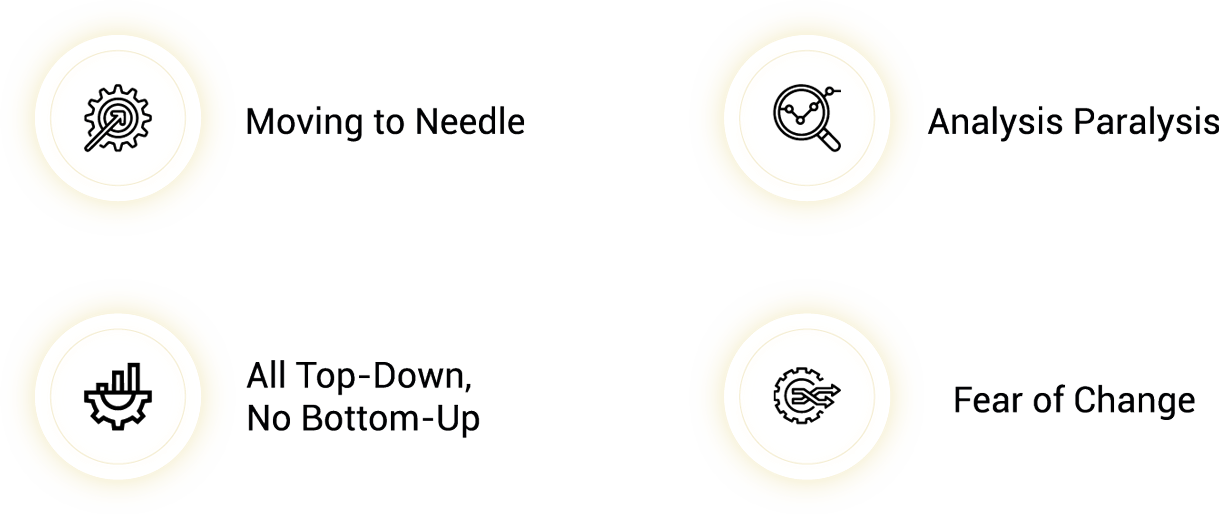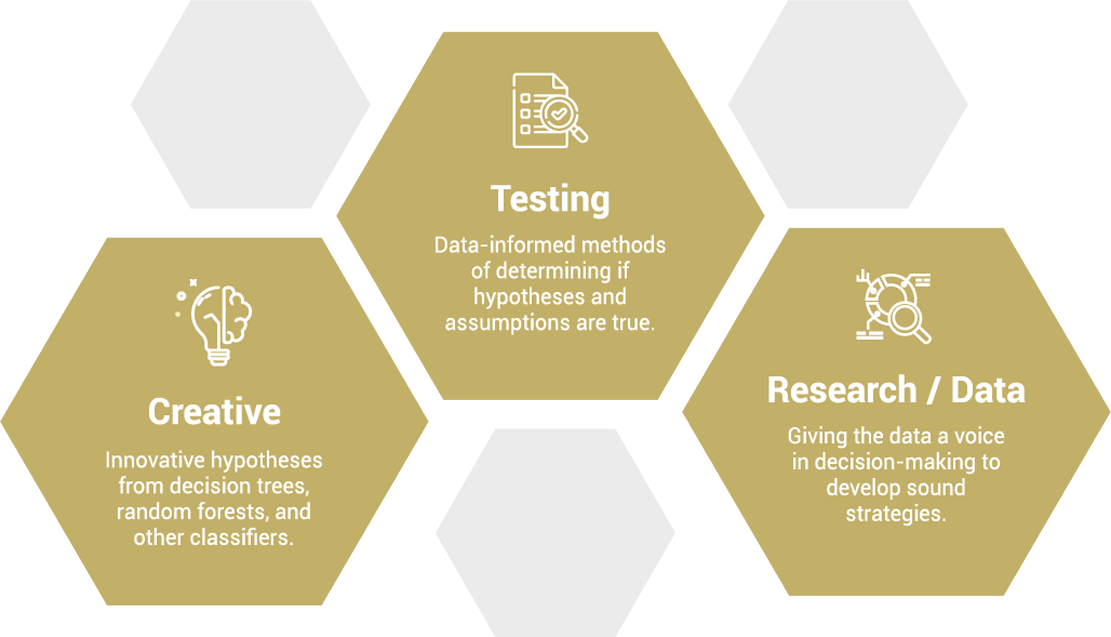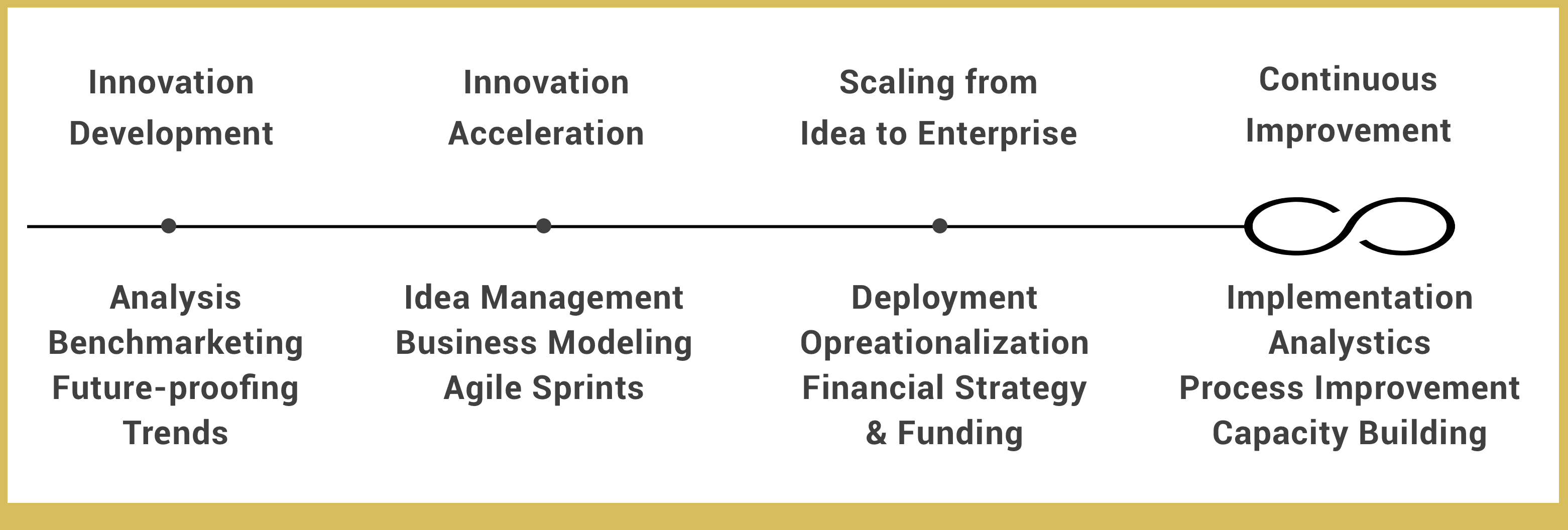Creating customer value share by generating innovative ideas for products + services, overcoming strategic + operational challenges, or developing + refining their processes through new technologies. For creating strategic roadmaps for your organization, see our business and organizational purpose services.
Innovation And Strategic Delivery
Moving from todays conditions towards creating greater customer value.
Starting the innovation process
When needed, organizations are accustomed with employing processes to guide operational improvements, but they are not used to having structures or methodologies built around innovation. Their internal teams such as R&D or brand management are traditionally tasked with generating ideas, but companies’ leaders don’t recognize the value of directing and maximizing their concepts through an established, disciplined process. It may be the word “innovation” itself and its association with unstructured creative thought as the reason why many don’t view it as a disciplined system.
This is the critical difference between simply generating ideas versus intentionally channeling creative thought through a repetitive course of activity that enables learning and testing to transform viable ideas into practical reality.
What blocks innovation: common issues

Many organizations regardless of size, and often irrespective of their industry prominence, struggle with innovation. Entrenched strategic and cultural barriers often hinder the progress of generating relevant, viable business ideas and channeling them into profitable, competitive products and services. Exploring each of these four roadblocks can help organizations expose their shortcomings and make measurable progress.
Moving the Needle
Oftentimes, organizations mistake daily activity for progress. They may have a documented corporate strategy and believe they have a methodology for directing and channeling creative ideas in the service of that strategy, but their creative process lack direction, alignment, and the momentum that comes with a defined and interconnected purpose. Consequently, different disciplines within the organization such as R&D, IT, or brand management tasked with generating innovative ideas, will pursue different lines of reasoning and research.
Of course, organizations will benefit from the acquired knowledge. Your research may be teaching you a great deal about trends in technology or advances in science. The data you’re gathering may be informing you about markets, consumers, and competition, but knowledge gathering isn’t moving the needle toward mounting an innovative and viable market introduction or response to a competitive trend.
In our approach to innovation, we’re constantly ensuring all functional areas involved in the creative process are in alignment with corporate strategy. This requires constant testing to determine that we are optimizing the best possible outcome for the growth of the organization while senior leadership receives frequent updates to support decision-making. Since we assume the workload and risks inherent in the innovation process, you don’t have to incapacitate your own talent and tax your financial resources researching and not moving the needle.
Analysis Paralysis
Organizations spend a lot of time researching options to make sure they’re making the best choice. And while choice allows companies better results, it also leads to greater indecision or wasting of talent and resources generating minimally viable product and service ideas without market validation. The paralysis of overthinking alternatives for fear of making the wrong choice prevents companies from making decisions and potentially missing market opportunities.
An indecision can be far more harmful to a company in competitive, fast-paced industry than a wrong decision. You can quickly learn from your mistakes and move up. The intent of our innovation practice is to run ahead of and future-proof your current corporate strategy by interrelating creative, research, and testing of ideas and designs. We separate out the issues that demand continued analysis and deliberation versus those concerns that demand a decision be made quickly so your company can make its market windows.
All Top-Down, No Bottom-Up
A third roadblock to innovation occurs when company leaders generate high-level strategies that look good on paper but are not actionable or misguided. Executives consumed with running their businesses are not on top of of current events or briefed daily on future trends to recognize potentially fatal errors in their reasoning and ideas. Their worlds necessarily center on manufacturing and distributing their product lines and serving customer needs. They’re not in the business of constantly monitoring and researching potentially disruptive inventions, technologies, consumption trends, and competitors.
In our practice, directives may come from the top and filter down, but verification and validation can only come from the bottom up. We enhance the innovation process through our Six Sigma expertise. We believe innovation is also a result of continuous improvement to product lines and services, operational efficiencies, and product design and durability.
Fear of Change
In many aspects, we are hardwired to resist change. Our bodies’ complex inertia, or resistance to change, is important for maintaining a state of homeostasis necessary for our survival. Applied to a business setting, our inherent resistance to change can often translate to a fear of change in management, in ownership, in company reorganization, or in increased automation or digitization. It is this aversion to disruption that prevents organizations from embracing the inevitability of change and, as a result, staying ahead of the marketplace. Industries are continuously disrupted and the pace of disruption will continue to accelerate with unremitting innovation in technology and manufacturing.
We provide your executive decision makers with insights and choices to not only alert you to disruptions, but also to enable you to be at the front of change and emerge as one of the disruptors. We become your internal R&D department, accelerating the innovation process behind your product concept and getting it to market as fast as possible and in the best way possible.
Ready for change: becoming a more innovative organization
Through our experience and practice, we have helped companies become successful at bringing winning new products and services to market by providing a structured discipline from which the best ideas are advanced through the innovation process. Our four steps to becoming an innovative organization begins with approaching innovation as a continuous process; a go-to-market strategy that accelerates the movement of ideas through creative, research, and testing; an objective and thorough view of ideas at an enterprise level; and a discipline for continuous innovation process improvement.
Innovation Development
Becoming an innovative organization necessitates giving structure to your creative ideas. We do the work of analyzing concepts for viability and benchmarking them against competition and market acceptance. We empower internal decision makers to make the strongest decisions possible by providing them all the information they need to decide whether to move forward.
Our providing structure, analyses, and monitoring the market for trends means companies and their leaders do not have to invest all their time and resources and can concentrate on day-to-day business without having to worry if they are passing up the next important technology or missing a market trend.
Innovation Acceleration
The term “agile sprints” finds its origins in the field of software development where programmers are tasked with creating and testing new code. A sprint is a short time period in which self-organizing software development teams work within an agile project management framework to work on a problem, learn through experience, and improve continuously.
We apply the same principles in our Go-to-Market (GTM) strategy and implementation plan for an organization’s new products and services. Our agile project management framework includes an organizational component paralleling your company’s functions and responsibilities—from chief operations officer to project manager—defining how the organization would need to structure its business to benefit fully from the change brought by the new product, new technology, new marketing channel, or new market segment.
We become a fully functional skunk works for the organization, working outside the normal R&D, operations, project management, and reporting channels within an organization, unencumbered by internal processes and able to move the needle on developing, researching, and testing innovations quickly and giving continuous discovery readouts to the senior team or project sponsor, enabling them to make well-thought through decisions for going to market first.
Scaling from Idea to Enterprise
The first level of insight we provide to senior leadership is the viability of the idea. We define how your organization would need to structure its business to benefit fully from the changes that would come with a new product, service, or technology introduction.
Your lens broadens as we draft and test different models of business structure and financial scenarios necessary to scale your idea to an enterprise level business. We assess your ability to take on the increased workload in a cost-effective manner while meeting the demands of your business without compromising or overstretching critical functions such as HR, R&D, manufacturing, operations, sales, and finance.
Continuous Improvement
Not only do we view innovation as a process, but we see it as a continuous process. You may now be or may become a market leader through your successful new business or product, but given the competitive nature of our world, it will not be long before another entity launches a new business, launches a superior product, or introduces a better service.
To remain competitive, innovative organizations are always listening to their people and to the marketplace. They are constantly looking out over the horizon and finding ways to improve or change their offering in service of their purpose. Our support and guidance comes from our ear-to-the-street validation of your innovative strategies and applying Six Sigma principles and tools to build in best practices for process improvement and capacity building so you may remain a competitive market leader.
Let’s Discuss.
Our consultants are happy to lend ideas and approaches to support your decision making. Contact us today for a quick strategy session.

READ MORE OF OUR INSIGHTS & THOUGHT LEADERSHIP ON INNOVATION
Filter
Want to hear more from us?
Receive ideas, innovative business approaches, and new study information directly to your inbox.






